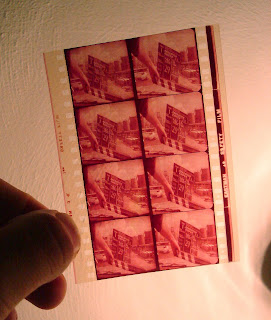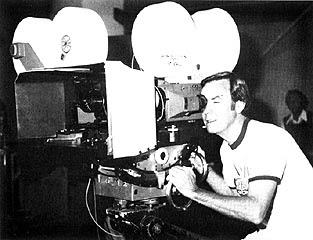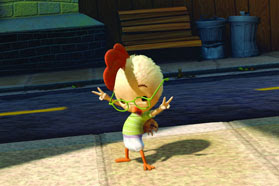
Anamorphic Side-by-Side 3-D on Film - a bit like Cinemascope for 3-D
Very recently I had an e-mail conversation with 3-D Revolution’s Gary Palmer on 3-D, HD, the best 3-D filming solution currently available and the Pace Fusion 3-D camera issues. The conversation touched upon many core issues of current 3-D film production and, I feel, reflects what many stereographers today think and feel but are not saying out loud. Or maybe we just share a very different viewpoint of 3-D Stereoscopic Film Production from the stereographic profession. Either way, I though it would be a nice read and possibly even useful to publish this conversation in the 3-D Film & Animation Production Blog…
And so here it is. Alexander Lentjes
You can find Gary’s marvellous work on the 3-D Film List at 3-D Revolution Productions here:
www.the3drevolution.com/3dlist.html

Twin-HD machine camera 3-D setup
Gary Palmer starts with two questions:
First, what do you think would be the ideal 3-D shooting format? In all the years I've been studying this subject, my own 'favourite' has to be the 65mm single-strip system devised by Jan Jacobsen in the 1960's, in which left-right 35mm frames are placed side by side in the space normally occupied by a single 65mm frame, and subject to an anamorphic squeeze, resulting in a 2.21:1 aspect ratio. This allows for *full* 35mm resolution. Transferred to Digital 3-D format at 4K resolution (reconfigured to 2.39:1 AR), this would surely provide the best and brightest 3-D format of them all, above and beyond anything so far offered by HD origination…

The late Jan Jacobsen working on one of his camera systems

65MM Side-by-side film strip - photo courtesy of Roloff deJeu
Second, going back to those comments you made earlier concerning the poorly composed images from the Fusion 3-D rig. Surely in today's world of digital post-production, the kind of badly-converged imagery you mentioned would be noticed by someone in the editing suite? How on earth can such material make its way to the screen in today's digital environment? After all, if *you* noticed problems, surely it must have been evident to others? It'll be interesting to see how both SCAR and JOURNEY 3-D measure up when they're finally released to theatres in the New Year...

Steve Hines with his superior 65mm Hines Rig
Alexander Lentjes answers:
Hmm, an interesting question about the ideal 3-D shooting format. I would have to vote for the twin-65mm Hines Rig that Disney commissioned for the MAGIC JOURNEYS and CAPTAIN EO shoots and has used on all their subsequent 3-D productions. Yes, there is loss of light, but there is a same amount of loss in a lens adapter like the side-by-side one you describe. The disadvantage of a S-B-S adapter is the need for anamorphics, which will often introduce geometric distortions and thus parallax issues. It's much more compact, though, and if you compare one 65mm camera with a twin-65mm camera rig, it's clear which setup is the most practical of the two. So it's a choice of handle-ability vs. pure quality. If you have the lights and the hydraulic camera cranes and cable systems, go for the twin-camera solution!
Of course, in that light, one must mention the twin HDV camera solution as that finally means a portable twin-camera rig (shoulder mount or steadicam), but then again HDV uses a low resolution compare to true HD and 35mm so for theatrical release it may be not that interesting.
 Twin-HDV 3-D Rig solution for hand-held shooting
Twin-HDV 3-D Rig solution for hand-held shootingA side-by-side twin-camera solution like Fusion 3-D is always going to introduce a big interaxial and for that reason alone it should be approached with due care. Why do you think there has been so much work going into getting those darn lenses closer together over the years? Surely not to then just ditch a century of cinema research and simply shoot with a 70-75mm interaxial!

A very large interaxial for a giant-POV type shot, dwarfing the imagery shot
Also, they shouldn't be touching that convergence button as much as they do. Sure, it's a tool in 3-D, but one that must be used with utmost limitation and due care - not per default and without any consideration for its consequences. Like HD is a step back in comparison to 35mm and especially 70mm, 3-D appears to be devolving with the current Stereo Camera trends...
3-D professionals should be able to see that the Pace imagery is uncomfortable to watch and dwarfs all subject matter. But it appears that somehow vertical parallax is suddenly acceptable on a professional level - and my biggest fear is that these professionals are just shooting themselves in the foot because Joe Bloke the Consumer is going to be very discomforted and angry when he sees that material in cinemas and on his brand new 3-D TV. The industry should acknowledge that 3-D filming is just not the same as 2-D filming - but they're selling (and buying) it that way right now!
Gary responds:
The reason I asked the question is because I share your aversion to the idea of HD replacing 35mm (or 65mm) film, and was wondering what might be used instead of HD. The various single-strip 35mm solutions are fine for what they are, but they involve cutting the 35mm frame in half, with all the attendant loss of resolution. I absolutely *despair* that Super 35 has become the widescreen format of choice these days (it isn't 'widescreen' at all, it's 'cropscreen') for that very reason.
The dual-65mm rig would certainly provide excellent images and would allow for high-grade digital prints (as long as 4K was used, of course). However, given the size of the cameras and the rigs needed to control them, it doesn't seem practical in modern filmmaking terms, especially if you need to cover a particular scene with two or three cameras at once.

True 65mm Twin-camera setup: bulky and heavy...
The post-production issues surrounding any future productions shot in single-strip 65mm should not be an insurmountable problem for any DP who takes such issues on board and is careful during principal photography… I think dual-65mm is too impractical for modern filmmaking practices and won't be considered anytime soon, whereas the development of lightweight cameras for single-strip 65mm amounts to a more reasonable expectation.
James Cameron and co. want HD to become the international standard. Not surprising, given that Cameron and most of his contemporaries have been trying to blur the boundaries between film and TV since around 1990. When was the last time you saw a film on a Big Screen which didn't look like a dress rehearsal for the DVD release? Note the preponderance of close-ups and medium shots, the 'TV-friendly' two-shots, etc.
It's still early days in the 3-D renaissance. And it's interesting that you and I both chose a 65mm solution, quite independently of one another. Who's to say 65mm *won't* be considered by Hollywood in due course, by filmmakers who care about the images they're creating (not an unreasonable assumption - parts of the new BATMAN film are being shot in Imax format, for example)? Who's to say lightweight cameras capable of single-strip/anamorphic (or even spherical) 65mm won't be developed as the 3-D revolution gathers pace, even as types like Cameron and Rodriguez continue to insist HD is the 'future of film'?

Spy Kids 3-D: shot on HD and almost fully against Greenscreen
Again, it's still early days, and no one is going to accept those flaws for very long. I say, wait until SCAR and JOURNEY 3-D arrive in cinemas next year. After all, it may not be the Fusion cameras at fault, but those who are using them!
So far, Joe Public has seen very little of the digital 3-D revolution except animated films. It's the *live-action* stuff that's going to decide the future of 3-D acquisition, and we haven't seen nearly enough of it to make a final judgement.

Chicken Little: remember that 3-D Animated CGI title?
We're on the brink of something marvellous. Along with colour, sound and widescreen, 3-D completes the illusion of film as a window on the world (and any other world filmmakers care to imagine!). We have the means to get it right this time, and I refuse to believe *everyone* who works in the format is going to stand for the 'second-best' option proffered by Cameron and his associates...

Aliens of the Deep: underwater 3-D by James Cameron & Vincent Pace
No comments:
Post a Comment